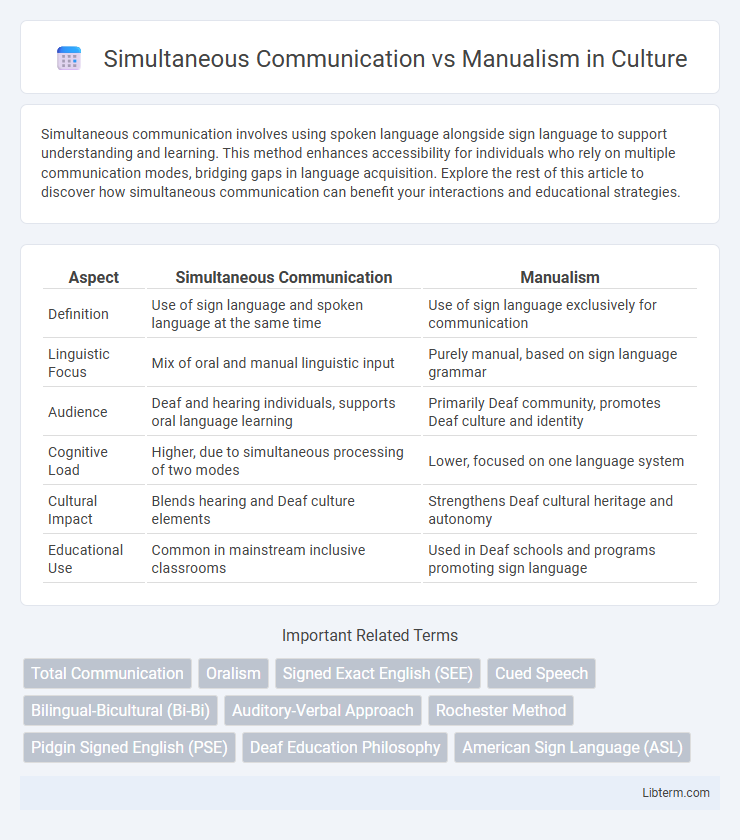Simultaneous communication involves using spoken language alongside sign language to support understanding and learning. This method enhances accessibility for individuals who rely on multiple communication modes, bridging gaps in language acquisition. Explore the rest of this article to discover how simultaneous communication can benefit your interactions and educational strategies.
Table of Comparison
| Aspect | Simultaneous Communication | Manualism |
|---|---|---|
| Definition | Use of sign language and spoken language at the same time | Use of sign language exclusively for communication |
| Linguistic Focus | Mix of oral and manual linguistic input | Purely manual, based on sign language grammar |
| Audience | Deaf and hearing individuals, supports oral language learning | Primarily Deaf community, promotes Deaf culture and identity |
| Cognitive Load | Higher, due to simultaneous processing of two modes | Lower, focused on one language system |
| Cultural Impact | Blends hearing and Deaf culture elements | Strengthens Deaf cultural heritage and autonomy |
| Educational Use | Common in mainstream inclusive classrooms | Used in Deaf schools and programs promoting sign language |
Understanding Simultaneous Communication
Simultaneous Communication (SimCom) combines spoken language with signing to enhance language accessibility for deaf or hard-of-hearing individuals, facilitating more effective understanding by presenting information through multiple channels simultaneously. Unlike Manualism, which relies exclusively on sign language as the primary mode of communication, SimCom aims to support both auditory and visual processing, improving comprehension in diverse educational and social settings. Research indicates that SimCom can aid in language development and cognitive engagement but may also require careful adaptation to avoid communication overload or reduced clarity.
Defining Manualism in Deaf Education
Manualism in deaf education refers to the exclusive use of sign language as the primary mode of instruction and communication, emphasizing visual-manual language proficiency. This approach contrasts with Simultaneous Communication, which blends sign language with spoken language, often limiting the natural depth of sign. Prioritizing manualism supports cognitive and linguistic development by fully immersing students in a rich, accessible visual language environment.
Historical Background of SIMCOM and Manualism
Simultaneous Communication (SimCom) originated in the 1970s as an educational method combining spoken language and sign language to support deaf and hard-of-hearing students in mainstream classrooms. Manualism, dating back to the early 19th century, emphasizes the use of fully developed sign languages, such as American Sign Language (ASL), as the primary mode of instruction and communication for the Deaf community. The historical evolution of SIMCOM reflects attempts to integrate oral and manual methods, while Manualism maintains a strong cultural and linguistic foundation rooted in Deaf heritage.
Key Differences Between SIMCOM and Manualism
Simultaneous Communication (SimCom) involves the concurrent use of spoken language and sign language to facilitate understanding, blending speech and signing to support both hearing and Deaf individuals. Manualism emphasizes the exclusive use of sign language without spoken language, prioritizing visual communication in educational and social contexts. Key differences include SimCom's reliance on dual modalities for communication versus Manualism's focus on purely manual, visual language, affecting language acquisition strategies and accessibility for Deaf users.
Benefits and Limitations of Simultaneous Communication
Simultaneous Communication (SimCom) combines spoken language with manual signs to support communication for individuals with hearing impairments, enhancing speech reading and auditory processing. Benefits include providing immediate visual and auditory cues, which can facilitate language development and comprehension in diverse settings. Limitations involve the potential for reduced sign clarity and slower signing speed, which may hinder full access to manual language nuances compared to Manualism, where sign language is used exclusively and more naturally.
Strengths and Challenges of Manualism
Manualism offers a rich visual language through American Sign Language (ASL), promoting natural language development and fostering strong bilingualism in Deaf individuals. The strength of manualism lies in its cultural immersion and ability to facilitate nuanced, expressive communication without reliance on spoken language. Challenges include limited accessibility for those unfamiliar with ASL and potential isolation in predominantly hearing environments where spoken language is preferred.
Impact on Language Development and Literacy
Simultaneous Communication (SimCom) blends spoken language and sign language, often resulting in reduced clarity and slower language acquisition compared to Manualism, which prioritizes pure sign language use. Research shows that children exposed to Manualism tend to develop stronger foundational language skills and higher literacy rates due to consistent visual language input. SimCom's divided attention approach can impede efficient language processing, negatively affecting vocabulary growth and reading comprehension in Deaf and hard-of-hearing learners.
Perspectives from the Deaf Community
Simultaneous Communication merges speech and sign language, aiming to enhance accessibility but often faces criticism from the Deaf community for prioritizing spoken language over natural signing. Manualism, which emphasizes exclusive use of sign language, is valued for preserving Deaf culture and promoting linguistic identity without relying on speech. Many Deaf individuals advocate for manualism as it centers authentic Deaf experiences and fosters clearer communication within the community.
Educational Settings: Choosing SIMCOM or Manualism
In educational settings, choosing between Simultaneous Communication (SIMCOM) and Manualism depends on students' language acquisition needs and communication goals. SIMCOM integrates sign language with spoken language, promoting bilingualism but may compromise clarity for some learners, while Manualism emphasizes exclusive use of sign language, fostering deeper visual language proficiency. Educators prioritize Manualism for deaf students seeking full access to sign language culture, whereas SIMCOM suits environments aiming to support both spoken and sign language development.
Future Trends in Deaf Education Approaches
Future trends in Deaf education increasingly emphasize individualized learning models that blend Simultaneous Communication (SimCom) and Manualism to optimize language acquisition outcomes. Emerging technologies such as AI-driven sign language recognition and augmented reality tools are enhancing the effectiveness of both approaches by providing real-time feedback and immersive learning experiences. Research indicates a shift toward inclusive curricula that prioritize bilingual-bicultural competencies, fostering cognitive development and cultural identity among Deaf students.
Simultaneous Communication Infographic

 libterm.com
libterm.com